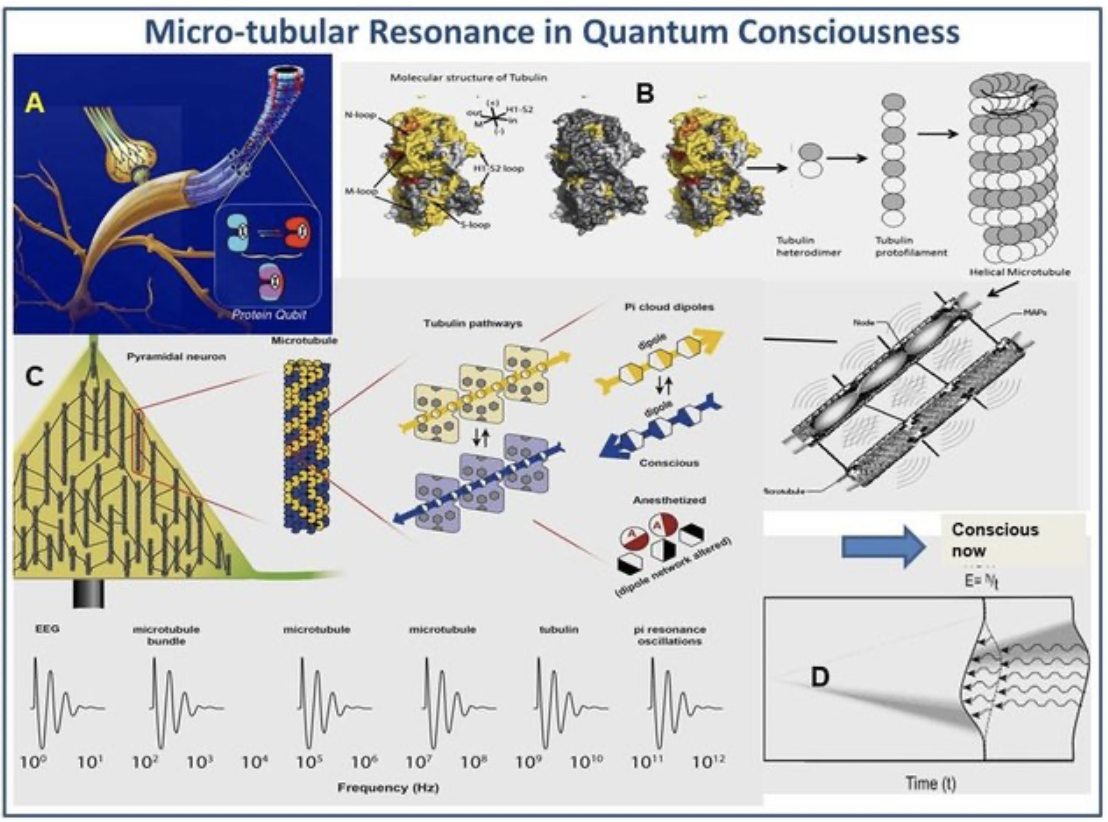 Scale-invariant Symmetry Breaking of a Musical Master-code from a 5-D Superfluid Sub-Quantum Space Is Instrumental in the Fabric of Reality, Life Conditions and Cosmic Consciousness
Scale-invariant Symmetry Breaking of a Musical Master-code from a 5-D Superfluid Sub-Quantum Space Is Instrumental in the Fabric of Reality, Life Conditions and Cosmic Consciousness
Neuroquantology
October 13, 2021
Meta-analysis of current biomedical and biophysical literature revealed the presence of a fractal pattern of discrete EMF frequency bands, in a wide range of animate and non-animate systems, framed as the Generalized Music (GM)-scale biophysical principle and also applied by us to study cognitive brain function as well as quantum mechanical aspects of first life. In this respect, it is proposed that nature is guided by a resonating set of quantum vacuum fluctuations of an all-pervading zero-point energy (ZPE)-field. It was shown that the toroidal GM-code can accommodate 4 spatial dimensions, in line with the Kaluza Klein concept as a feature of the Sub-Quatum SFQS, conceived as a homogenous 5-D space-time manifold. The related photon/phonon and soliton fluxes can be modelled by toroidal geometry as also obtained from Perelmann-Ricci-Flow mappings, processes that enable crucial wave damping and tone separation. The GM-scale exhibits a self-similar fractal) wave pattern that gives rise to a series of more than 500 EMF frequencies from the Hz to the GHz ranges, thereby exhibiting a field-like character. In this paper we report on a series of 46 experimentally determined ZPE-frequencies, from 15 separate studies, that fit the GM-scale eigenvalues closely. The central message of these quantum wave studies implies a cosmic connectivity operating in a primordial context, possibly related to known bounce models of our universe, that is likely also mirrored in life processes, including the human brain. It is postulated that the generation of life in the cosmos resulted from a symmetry breaking from the homogenous 5-D manifold that contains condensed boson type of quantum wave information and is instrumental in past/future transactional information processing
See publication
Tags: AI, Quantum Computing
The Information Cycle and Biological Information Management
Springer
February 14, 2021
In an informational matrix, there is no actual empty space. The spaces between zones of probabilistic information have been called the "Third State" by Forshaw (2016). These spaces represent a universal value that is common to all data and information. ...
See publication
Tags: Quantum Computing
Biophysics of Consciousness: A Scale-Invariant Acoustic Information Code of a Superfluid Quantum Space Guides the Mental Attribute of the Universe
Springer
October 30, 2020
In this chapter, we postulate an integral concept of information processing in the universe, on the basis of a new biophysical principle, coined the generalized music (GM)-scale of EMF frequencies. Meta-analyses of current biomedical literature revealed the presence of a distinct pattern of discrete EMF frequency bands in a wide range of animate and non-animate systems. The underlying algorithm of harmonic solitonic waves provided a novel conceptual interface between living and non-living systems being of relevance for the areas of brain research as well as biological evolution. We hold that nature is guided by resonating quantum entities related to quantum vacuum fluctuations of an imminent zero-point energy (ZPE) field, also regarded as a superfluid quantum space (SQS). Since the whole human organism, including the brain is embedded in this dynamic energy field, a pilot wave guided supervenience of brain function is conceived. Conversely, the brain may write discrete informational states into the ZPE field as individual memory traces. Both information fluxes may be related to a holofractal memory workspace, associated with, but not reducible to the brain, that operates as a scale-invariant mental attribute of reality. Our concept, therefore, addresses the earlier postulated “hard problem” in consciousness studies.
See publication
Tags: Quantum Computing
Consciousness in the Universe is Tuned by a Musical Master Code, Part 2: The Hard Problem in Consciousness Studies Revisited
Quantum Biosystems | 2020 | Vol 11
May 20, 2020
Part 2 of this review article provides a novel conceptual bridge between living and non-living systems, being of relevance for the areas of biophysics, brain research, as well as for mechanisms of biological evolution. As to the latter aspect, the potential role of phyllosilicates (clay materials) in the generation of a primordial biofield is treated and seen as instrumental in a partially guided creation of first life. We hold, in general, that nature is guided by a discrete pattern of harmonic solitonic waves, likely originating from quantum vacuum fluctuations derived from an immanent zero-point energy (ZPE)/superfluid quantum space. Since the whole human organism, including brain is embedded in this dynamic energy field, a comprehensive model for human (self)-consciousness could be conceived. Evidence is presented for a pilot wave guided supervenience of brain function that may arise from a holofractal memory workspace, associated with, but not reducible to the brain, that operates as a scale-invariant mental attribute of reality. This field-receptive, workspace integrates past and (anticipated) future events and may explain overall ultra-rapid brain responses, as well as the origin of qualia as proposed in the so called hard problem of consciousness studies.
See publication
Tags: Quantum Computing
What Does This Mean for Evolution?
Springer
February 20, 2020
In 2010, the evolutionary biologist, mathematician, and geneticist, Richard Lewontin noted that the standard narrative of evolution by natural selection does not explain the actual forms of life that have evolved. He further contended that there is an immense amount of biology that is missing from neo-Darwinism. Other scientists also agree (Pigliucci 2007; Baluška 2009; Witzany 2010; Shapiro 2011; Torday 2015a, b; Miller 2016b, 2017; Miller and Torday 2018). Therefore, it can be defended that the central tenets of the modern synthesis should be questioned. Of these areas of inquiry, the most pertinent is the exact role and limits of natural selection in any evolutionary process. If selection has primacy in evolutionary development, does it proceed according to strict gene frequencies? Is it propelled by random genetic mutations? Is Crick’s central dogma that asserts a unilateral direction of the flow of biological information from DNA to RNA still applicable in the twenty-first century? Certainly, there is no requirement that the correct answers have to be any exact antipode of prior beliefs. Nor must any contradictions be absolute. Therefore, even a substantial reformulation of evolutionary development need not be an unyielding negation of the past. Instead, it is tasked to incorporate the weighty thoughts of prior generations of scientists and direct them toward a fuller understanding of this complicated issue.
See publication
Tags: Quantum Computing
Holobionts
Springer
February 14, 2020
In previous chapters, a differing point of initiation for evolutionary development has been introduced through concepts of information management and cell–cell communication. It has been emphasized that evolution proceeds quite differently than it had been supposed. Instead of random genetic variations based on intermittent replication errors, evolution can now be understood as a continuous self-referential process of self-modification in response to environmental stresses through natural cellular engineering and niche construction. Yet, to further comprehend how the modern synthesis must be altered, an accurate perception of the endpoint of all evolutionary processes must be explained. It is now known that all multicellular macro-organisms are holobionts. Taking ourselves as an example, it is currently estimated that there are many trillions of microbes—bacteria, viruses, fungi, and others—that are in us and on us (Sender et al. 2016). They outnumber our eukaryotic cells by a factor estimated by some to be up to 10 to 1 or more (Turnbaugh et al. 2007). When the total genetic complement of this microbial fraction is considered, the full genetic cohort of the associated microbiome outnumbers our innate genetic complement by perhaps as much as 100 to 1 (Bäckhed et al. 2005).
See publication
Tags: Quantum Computing, Construction
Cognition and the Living Condition
Springer
February 14, 2020
Our contemporary era permits a harnessing of fresh contemporary resources to evolutionary biology from the emerging fields of metagenomics (the direct study of genetic material from environmental samples), epigenomics (the complete range of epigenetic factors that influence gene expression), and hologenomics (the complete genetic complement of an organism, including its microbial fraction). None of these fields mattered or were even thought to exist within the twentieth century. With the productive application of critical research from these disciplines, evolutionary biology can now be explored from a vantage that was unavailable to Darwin and the myriad others that followed in the ensuing decades.
See publication
Tags: Quantum Computing
Reconciling Physics and Biology
Springer
February 14, 2020
For his entire life, Einstein retained a steadfast commitment to determinism. He believed that there is an objective reality that can be observed and accurately measured. If there was sufficient understanding and measuring capacity, any of the apparent indeterminacies of quantum mechanics would eventually be shown to be deterministic (Landsman 2009). His contemporary, the brilliant astronomer, mathematician, and physicist, Arthur Eddington, supposed differently. He had concluded that beyond any conceivable measuring, there is both more and less to any physical object. He sensed that the actual natural state always remains hidden within indeterminate variables (Durham 2003). Certainly, quantum theory points toward indeterminism, as it is underpinned by Heisenberg Uncertainty (the exact position and the exact speed of an object cannot be known simultaneously) and the Born Rule (an essential law within quantum mechanics giving the probability that a measurement on a quantum system will yield a given result) (Landsman 2009). Based on these within any quantum system, the outcome of any event is probabilistic and uncertain. When the Nobel Prize winners, Prigogine and Monod, attempted to scale these principles to biological systems, they argued for indeterminism (Prigogine and Stengers 1997; Merlin 2015). It is proposed that when biology is properly considered in the context of informational ambiguity and cell–cell communication across levels, there can be a productive unification of biology and quantum physics.
See publication
Tags: Quantum Computing
Darwin, the Modern Synthesis, and a New Biology
Springer
February 14, 2020
Any attempt to provide a coherent alternative evolutionary narrative to standard Darwinian tenets should offer a brief overview of the progression of scholarly thought about evolutionary mechanisms. All narratives focus on Charles Darwin's seminal “On the Origin of Species” (Darwin 1859). When Darwin offered that influential work in 1859, he was unaware of the existence of genes. He was a naturalist with a gift for scrupulous observation. Based upon his studies, he proposed the major dictums that have since guided evolutionary thoughts. He offered two linked primary arguments. Evolution proceeded by a process of natural selection through the gradual modification of inherited variations. Notably, the concept of natural selection was not original to Darwin. In 1831, a Scottish horticulturalist, Patrick Matthew had proposed a theory of natural selection, and Darwin was acquainted with his work (Rampino 2010). Another English naturalist and explorer, Alfred Russel Wallace was in communication with Darwin prior to his publication of On the Origin of Species.
See publication
Tags: Quantum Computing
Networking from the Cell to Quantum Mechanics as Consciousness
Springer
February 14, 2020
A prior series of peer-reviewed journal articles (Torday and Rehan 2007; Torday 2013, 2015a, b, 2018a, b) and monographs (Torday and Rehan 2012; Torday et al. 2017) have elucidated how cell–cell signaling for form and function during embryologic development can be exploited to determine the evolution of such processes. This is particularly true when the mechanisms of development are identified as the source of phylogenetic changes in physiologic traits such as the lung, kidney, skin, and bone (Torday and Rehan 2012, 2017).
See publication
Tags: Quantum Computing
Non-genic Means of Information Reception and Exchange
Springer
February 14, 2020
Aside from the transfer of genetic material and a large array of bioactive molecules by endocytosis and other cellular mechanisms, there are many additional sources of information exchange among cells. The primary cilia are one such example. These slender projections on microbes and cells are an essential element for both their communication processes and mobility (Wheatley et al. 1996). They also serve an important sensory function that is part of the cell’s analysis of mechanical and chemical signals, which is a consequential part of their information space. As such, they are part of what is termed the “senome” of the cell. The “senome” represents the summation of all the sensory inputs of the cell derived through the use of all of its sensory apparatus and tools (Baluška and Miller 2018). This is the means by which the cognitive cell can assess its environment as it attempts to maintain homeostatic balance. Even bacteria show a high degree of sensory complexity linked to sensorimotor circuits that activate at the plasma membrane and ramify throughout the cell (Lyon 2015).
See publication
Tags: Quantum Computing
Consciousness in the Universe is Tuned by a Musical Master Code: A Hydrodynamic Superfluid Quantum Space Guides a Conformal Mental Attribute of Reality. The Hard Problem in Consciousness Studies Revisited
Researchgate
December 01, 2019
This review article submits an integral concept of information processing in the universe on the basis of a generalized musical (GM)-scale of discrete EMF frequencies. Meta-analyses of current biophyisical literature revealed the effects of similar EMF frequency patterns in a wide range of animate and non-animate systems. This provided a novel conceptual bridge between living and non-living systems, being of relevance for the areas of biophysics, brain research, as well as for mechanisms of biological evolution. As to the latter aspect, the potential role of phyllosilicates (clay materials) in the generation of a primordial biofield is treated and seen as instrumental in a partially guided creation of first life. We hold, in general, that nature is guided by a discrete pattern of harmonic solitonic waves, likely originating from quantum vacuum fluctuations derived from an immanent zero-point energy (ZPE)/superfluid quantum space.
See publication
Tags: Quantum Computing
Consciousness in the Universe is Scale Invariant and Implies an Event Horizon of the Human Brain
NeuroQuantology
September 20, 2017
Our brain is not a "stand alone" information processing organ: it acts as a central part of our integral nervous system with recurrent information exchange with the entire organism and the cosmos. In this study, the brain is conceived to be embedded in a holographic structured field that interacts with resonant sensitive structures in the various cell types in our body. In order to explain earlier reported ultra-rapid brain responses and effective operation of the meta-stable neural system, a field-receptive mental workspace is proposed to be communicating with the brain. Our integral nervous system is seen as a dedicated neural transmission and multi-cavity network that, in a non-dual manner, interacts with the proposed supervening meta-cognitive domain. Among others, it is integrating discrete patterns of eigen-frequencies of photonic/solitonic waves, thereby continuously updating a time-symmetric global memory space of the individual. Its toroidal organization allows the coupling of gravitational, dark energy, zero-point energy field (ZPE) as well as earth magnetic fields energies and transmits wave information into brain tissue, that thereby is instrumental in high speed conscious and subconscious information processing. We propose that the supposed field-receptive workspace, in a mutual interaction with the whole nervous system, generates self-consciousness and is conceived as operating from a 4 th spatial dimension (hyper-sphere). Its functional structure is adequately defined by the geometry of the torus, that is envisioned as a basic unit (operator) of space-time. The latter is instrumental in collecting the pattern of discrete soliton frequencies that provided an algorithm for coherent life processes, as earlier identified by us.
See publication
Tags: Quantum Computing
Processes of Science and Art, Modeled by Toroidal Flux of Information
Researchgate
March 15, 2017
Abstract Processes of Science and Art, Modeled by Toroidal Flux of Information Dirk K.F. Meijer, PhD An attempt is made to model the structure of science and art discovery processes, in the light of currently defined ideas on the societal flow of knowledge and conservation of information, using the versatile physical concept of toroidal geometry. This should be seen as a heuristic model that is open for further development and evolution. The scientific process, has been often described as a iterative and/or recurrent process. Current models, explain the generation of new knowledge on the basis of a number of sequential steps (activities) operating in a circular mode. This model intrinsically assumes this process to be congruent for all individual scientific efforts. Yet, such a model is inadequate to fully describe the whole integral process of scientific discovery as an ongoing interactive process, performed in a cumulative fashion. This implies that any new cycle starts from a different perspective or, optimistically seen, is initiated from a higher level. It seems appropriate for this reason to disregard the cyclic model and replace it by a spiral modality that takes into account the ongoing rise of scientific perspective. Also, any model that attempts to picture the scientific process, should include potential interactions of concepts or hypotheses, in the sense that concurrently developed concepts may (mutually) influence each other and even may be mixed or superposed or alternatively may lead to concept extinction. Science and art progression, both seen as an individual effort and a historically-based flow of events, is inherently a non-linear or even sometimes a chaotic process, where even relatively small changes can lead to major scientific transformation
See publication
Tags: Quantum Computing
Phonon Guided Biology: Architecture of Life and Conscious Perception Are Mediated by Toroidal Coupling of Phonon, Photon and Electron Information Fluxes at Discrete Eigenfrequencies
NeuroQuantology
December 01, 2016
Recently, a novel biological principle, revealing specific electromagnetic (EM) radiation frequencies that sustain life, was presented by us on the basis of an evaluation of 175 biological articles concerning beneficial effects of electromagnetic waves on the state of living cells. This concept was also based on a very similar range of frequencies emitted by a clay-mineral catalyst of RNA synthesis that may have been instrumental in the evolutionary initiation of first life, and therefore was tentatively designated as “Algorithm of Life”. The particular spectrum of frequency bands indicate that nature seems to employ discrete eigenfrequencies or standing waves that match precisely with an acoustic scale, with frequency ratios of 1:2, and closely approximated by 2:3, 3:4, 3:5, 4:5 and higher partials, allowing the discrete frequencies to be expressed in scalars. Our further studies clearly indicate now that this “life algorithm” pattern matches very well with the mathematical calculations of W. Ritz (1909) to compute eigenfrequencies of the sound induced geometric patterns. These have been earlier demonstrated through membrane vibration experiments of E. Chladni (1787), as well as several follow up studies from 1970-2013. Our findings, therefore, touch upon the science of acoustics, also since we show that the discrete frequencies could be modeled by music torus geometry. We postulate that the spectrum of EM frequencies detected, exhibit a quantum ordering effect on life cells on the basis of induction of geometric wave patterns. These constitute phonon/photon and electron wave energies, and quantum oscillations at far-infrared frequencies, that are communicated through toroidal constructive interference into scalar wave information.
See publication
Tags: Quantum Computing
Quantum Wave Information of Life Revealed: An Algorithm for Electromagnetic Frequencies that Create Stability of Biological Order, With Implications for Brain Function and Consciousness
NeuroQuantology
January 20, 2016
We propose a hypothesis of a mathematical algorithm for coherent quantum frequencies, that may create stability of biological order. The concept is based on an extensive literature survey, comprising 175 articles from 1950 to 2015, dealing with effects of electromagnetic radiation on in vitro and in vivo life systems, indicating that typical discrete coherent frequencies of electromagnetic waves are able to stabilize cells, whereas others cause a clear destabilization. We find support for the hypothesis of H. Fröhlich, that a driven set of oscillators condenses in a broad energy range, may activate a vibrational mode in life organisms at room temperature. Taking into account the life sustaining frequencies, as extracted from literature, an algorithm of coherent frequencies of standing waves for the stability of biological order was inferred. Interestingly, we found that the origin of the particular biological algorithm can be mathematically approached by a selected “tempered Pythagorean” reference acoustic scale. The algorithm expresses one-dimensional wave equations known for vibrating strings. The origin of the biological algorithm was condensed in a mathematical expression, in which all frequencies have ratios of 1:2 and closely approach ratios of 2:3. This inferred algorithm was subsequently verified with regard to various frequencies of electromagnetic waves, as applied in the above-mentioned independent biological studies. It was also matched with a range of 23 different measured quantum resonances emitted by a selected inorganic silicate mineral, that is able to catalyze the oligomerization of RNA.
See publication
Tags: Quantum Computing
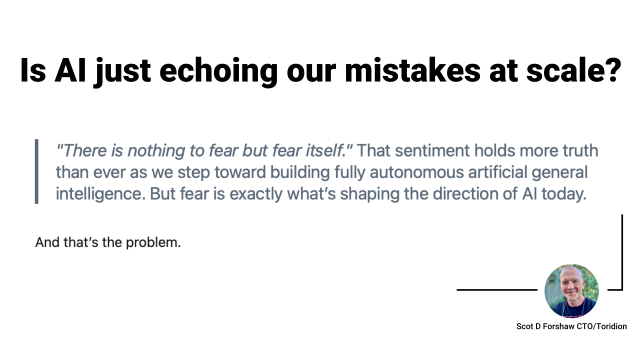 Let AI Want Something?
Let AI Want Something?
LinkedIn
July 08, 2025
We aren’t building AGI for what it could be - we’re building it based on what we fear it might become. Worse, we’re building it in our own image, with our own flaws, incentives, and biases baked in. If we keep doing that, the so-called “rise of AI” won’t be a rise at all-it’ll just be recursion. Machines echoing our mistakes, at scale.
See publication
Tags: Agentic AI, Agile, Emerging Technology
 The Implications of Indestructible Memory in AI
The Implications of Indestructible Memory in AI
LinkedIn
January 21, 2025
Imagine an AI system that could be rehabilitated to remember things that had once been erased. Not merely retrieving stored data from a backup, but reconstructing lost knowledge—relearning from fragments and filling gaps in its own memory as a human brain might after trauma. What if an AI could form memories that were not just resilient but non-fungible—incapable of being permanently lost, yet adaptable enough to evolve?
See publication
Tags: Quantum Computing
 TQNN vs. Transformers
TQNN vs. Transformers
Toridion
January 20, 2025
Transformers have dominated AI research and application landscapes for the past decade, powering models like GPT, BERT, and T5. These architectures have set new benchmarks in NLP, image generation, and multimodal learning. However, their immense computational demands, tokenization inefficiencies, and the inherent latency of autoregressive processing present limitations. Transformers will likely remain the dominant force in generative AI for NLP and multimodal learning, but TQNN presents an attractive alternative in industries prioritizing speed, efficiency, and adaptability. With ongoing optimizations in token weight recalibration and neural storage, TQNN could redefine how AI models handle massive-scale, high-frequency data streams.
Rather than replacing Transformers outright, TQNN’s rise suggests a future where specialized AI architectures coexist, each optimized for its own domain. In an AI landscape increasingly demanding real-time insights and lower computational costs, TQNN may just be the disruptive force needed to balance performance with efficiency.
See publication
Tags: Agentic AI, AI, Cybersecurity
 8% BTC hike more success for Quantum Inspired Machine Learning analytics engine Quantabotics
8% BTC hike more success for Quantum Inspired Machine Learning analytics engine Quantabotics
Linkedin
December 07, 2021
Perfect timing from Toridion's Quantum Inspired Machine Learning powered financial analytics "Quantabotics" Issues a SBI smart buy in at 10:05 UTC analytically projecting the market had bottomed out.
See publication
Tags: FinTech, Predictive Analytics, Quantum Computing
Buy low & Sell high — Use Quantabotics Smart Buy (SBI) machine learning to detect BTC bottom and drive Cryptohopper trades
Medium
November 12, 2021
Buying bitcoin low and selling high is a tried and tested logical strategy to grow your BTC profits. Quantabotics Smart Buy In (SBI) can help you trigger buys on predictable accuracy limits and statistical market forecasts. Using Toridion machine learning the TF API delivers statistical data to Quantabotics where you can set thresholds of when to buy BTC.
See publication
Tags: Cryptocurrency, FinTech, Quantum Computing
How to Switch Cryptohopper BTC Trading Strategies Automatically with Market Changes
Medium
October 28, 2021
How to Switch Cryptohopper BTC Trading Strategies Automatically with Market Changes
See publication
Tags: FinTech, Predictive Analytics, Quantum Computing
 The Artificial Intelligence Race won't be won by GPU's and TFLOPS
The Artificial Intelligence Race won't be won by GPU's and TFLOPS
Linkedin
August 19, 2020
As a recent MIT/IBM joint paper offers the strongest evidence yet that AI and Deep Learning are facing a performance crisis[1], I have to look critically at the big names still busy pushing away at GPU and logic based incremental improvements. The maths is in... it isn't going to work! Simply stuffing billions more transistors in a die and burning more energy won't reach the terminal velocity required to accelerate Deep Learning beyond a few more iterations of performance increase.
See publication
Tags: AI, Predictive Analytics, Quantum Computing
A Quantum Neural Network that solves 10,000 piece jigsaws from working memory in a human like way is a serious step toward thinking machines
Linkedin
May 07, 2019
Anyone interested in machine learning (ML) or Artificial Intelligence (AI) will have been seeing more and more talk of ML as it relates to Quantum Computing (QC). This is often called Quantum Machine Learning (QML). A lot of the talk seems like hype, but today Toridion Project a QML research company from the UK and Thailand demonstrated how QML can do things that no classical algorithm could hope to achieve by solving an arbitrary 10,000 tile picture puzzle by using short term working memory Neuroplasticity – a characteristic of human brains, not classical computers. The result is proof undeniable that quantum approaches to ML and AI have the capability to perform tasks that no classical approach can achieve, and outperform humans as the problem size increases.
See publication
Tags: AI, Predictive Analytics, Quantum Computing
 QUAKESCANNER MISSION I
QUAKESCANNER MISSION I
Visicom Scientific
December 31, 2016
All the latest data, forecasts and mission results from the Quakescanner Earthquake I Mission! Earthquakes are one of the most powerful and destructive natural forces on earth. Every year they claim 100's if not 1000's of lives globally. Forecasting earthquakes is notoriously difficult and despite millions of dollars of research annually, the ability to forecast them is still far from a reality.
See publication
Tags: Climate Change, Predictive Analytics
 An Artificial Life Developers Response to Deepak Chopra's Article - “Artificial Intelligence Will Never Rival the Deep Complexity of the Human Mind”
An Artificial Life Developers Response to Deepak Chopra's Article - “Artificial Intelligence Will Never Rival the Deep Complexity of the Human Mind”
Linkedin
July 05, 2016
“AI isn’t based on the truth.”
The article opens with the above assertion ...
As an AL developer and researcher I have no objection to the foregoing statement. I agree with Deepak Chopra, and would say “reality is quite obviously based upon uncertainty and principles that cannot be readily and recursively expressed or fully calculated – therefore very little is 'TRUE' in the scientific or philosophical sense of the word”. I cover this subject in much more detail in my paper “The Third State: Toward a Quantum Information Theory of Consciousness” (Forshaw, 2015).
See publication
Tags: AI
Quantum algorithm Identifies every major financial cycle in 45 years
Linkedin
January 26, 2016
Quantum Data Analytics promises the most radical shift in how future quantum based computer systems will process large data set that have little in the way of intuitive isomorphic relationships. This article is a window into experimental results being produced by Toridion Projects latest quantum tunnelling technology.
See publication
Tags: FinTech, Predictive Analytics, Quantum Computing
Classical versus Quantum determinism and Free Will for beginners
Linkedin
January 03, 2016
Classical determinism is the notion that some action or another has a predictable and calculable outcome. For example: dropping a ball.
Thermodynamics and Newtonian physics has these bits covered pretty well. So where does quantum fit into this? Quantum mechanics studies small stuff, not the ball itself but the components of the atoms that the ball is made from. Here at the scale, things get very difficult to measure and predict. I get asked frequently to explain the problem, and more so to explain how classical determinism can be derived from apparent quantum randomness. To illustrate the point I have devised a simple experiment you can do at home (or in your head). So here goes....
See publication
Tags: AI, Predictive Analytics, Quantum Computing
Prepare for Quantum Computing now - while you still can
Linkedin
December 17, 2015
The time for speculation is not a luxury one can afford much longer, because whilst the world at large looks the other way, Quantum Computers will come, and when they arrive, trust me they won't come with a trailer or a preview. The day Quantum Computing comes to town will be a commercial asteroid strike with species extinction proportions.
See publication
Tags: Quantum Computing
Prepare for Quantum Computing now - while you still can
Linkedin
December 16, 2015
"Quantum research is not the world of dreamers, it is the world of people who want to change the world."
The time for speculation is not a luxury one can afford much longer, because whilst the world at large looks the other way, Quantum Computers will come, and when they arrive, trust me they won't come with a trailer or a preview. The day Quantum Computing comes to town will be a commercial asteroid strike with species extinction proportions.
See publication
Tags: Quantum Computing
Predicting The Past – Facing up to the Hard Problem of Data Analytics
Linkedin
November 22, 2015
Everyone seems obsessed with predictive analytics these days. What will happen next, what will happen in 3 months.... I'd like to turn your attention to something we do everyday, something we trust as absolute fact, something we trust our absolute lives to. That something is what I call 'Predictive Historical Analytics' – the science of making up the past to fit the present so you can hopefully predict the future.
See publication
Tags: AI, Predictive Analytics
 Question Generation Technology (QGT) in Deep Learning - Why Defining New Questions Is More Important Than Finding Answers in Data Analytics.
Question Generation Technology (QGT) in Deep Learning - Why Defining New Questions Is More Important Than Finding Answers in Data Analytics.
Linkedin
November 04, 2015
For anyone heavily involved in the development of Deep Learning technology, by far one of the most difficult things we face is actually putting what is in our heads into meaningful words. By this I mean answering the many questions that the inquisitive audience ask of us. For example, I may be asked “what is this hidden region then?”.
See publication
Tags: AI, Predictive Analytics, Quantum Computing
 Neuroplasticity demonstrated in a Zero Logic Quantum Neural Network
Neuroplasticity demonstrated in a Zero Logic Quantum Neural Network
Linkedin
August 02, 2015
A recent development at Visicom Scientific is the creation of a primitive but highly capable Zero Logic Quantum Probabilistic Neural Network. Or ZLQNN for short, and in recent experiments (highlighted below), it was shown how information stored in a probabilistic form of layered frequencies could be shown to not only store information with 100% accuracy but also self organise, self repair and self create useful information without the use of logic or dedicated software to direct it.
See publication
Tags: AI, Predictive Analytics, Quantum Computing
 Toridion QML API BTC (Bitcoin) Cryptocurrency Prediction Performance 37 Hr Test October 1st - 2nd 2020 Results with Data
Toridion QML API BTC (Bitcoin) Cryptocurrency Prediction Performance 37 Hr Test October 1st - 2nd 2020 Results with Data
Toridion
October 03, 2020
We review the performance of the live predictions made by our API for the period 10/01/2020 9am UTC to 10/02/2020 9pm inclusive. The overall accuracy was calculated at 56.76% with 21 / 37 correct predictions. At a requested confidence >= 50% the accuracy was 21/36 = 58.33%. At 54% requested confidence, the accuracy was 13/19 = 68.42%. These results show that the quantum inspired machine learning model was successful at predicting Bitcoin moving average direction for > 56% of all market positions tested. Furthermore, where the requested confidence of the prediction was set to 54% (considered the forex trader magic win/loss threshold[1]) accuracy was 68.42%.
See publication
Tags: Cryptocurrency, Predictive Analytics, Quantum Computing
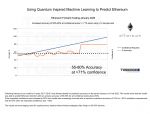 Quantum Inspired Machine Learning for Ethereum Cryptocurrency 2020 Forward Prediction with Results
Quantum Inspired Machine Learning for Ethereum Cryptocurrency 2020 Forward Prediction with Results
Research Gate
September 24, 2020
In this paper we present empirical results for 1 hour future prediction of the Ethereum cryptocurrency using quantum inspired machine learning [QML] for the month of January 2020. The results demonstrate accuracy that exceeds the 'magic win/loss' ratio of 54%. There is a generally held view that financial markets behave in a mostly unpredictable way[1]. Indeed observing the number of up and down events across the majority of currency pairs such as USD/GBP will reveal a largely even 50/50 distribution of events, lending weight to the random nature argument. In this study, we used a previously trained model of the Ethereum cryptocurrency[2] to forward test the models ability to confidently identify market patters with strongly probable outcomes 1 hour in the future. The model was tested for the month of January 2020 on a trained model for September 2017 to December 2019. Returning a 55-70% prediction accuracy at confidence levels >= 63%, the results demonstrate that cryptocurrency signal generation is a good candidate for quantum inspired machine learning powered predictive analytics.
See publication
Tags: Big Data, Predictive Analytics, Quantum Computing
 Toridion Quantum Inspired Machine Learning for Ethereum Cryptocurrency Prediction with Results
Toridion Quantum Inspired Machine Learning for Ethereum Cryptocurrency Prediction with Results
Research Gate
September 22, 2020
There is a generally held view that financial markets behave in a mostly unpredictable way[1]. Indeed observing the number of up and down events across the majority of currency pairs such as USD/GBP will reveal a largely even 50/50 distribution of events, lending weight to the random nature argument. In this study, we applied quantum inspired machine learning to 3 years of forex and cryptocurrency market data in an attempt to build a statistically strong model for the short term forecasting of the Ethereum cryptocurrency. The machine learning model was simultaneously trained on 8 fiat currency pairs and 3 cryptocurrency pairs. Subsequent back testing of the model for various levels of confidence indicated that the model was able to predict 1 hour in the future with better than 75% accuracy when the requested confidence level was > 63%. At higher confidence levels the accuracy increased until reaching 100% accuracy at 91% confidence. The results indicate that cryptocurrency signal generation is a good candidate for quantum inspired machine learning powered predictive analytics.
See publication
Tags: Cryptocurrency, Predictive Analytics, Quantum Computing
 Computational Advantages of Probabilistic Quantum Neural Networks in 'Real World' Applications
Computational Advantages of Probabilistic Quantum Neural Networks in 'Real World' Applications
Toridion
April 20, 2017
The achievement of a useful General Purpose Quantum Neural Network [QNN] promises the delivery of an important milestone on the journey toward harnessing the effective power of quantum computing when applied to data intensive application such as big data analytics. Here, we demonstrate how Toridion Quantum Neural Networks [TQNN] can deliver significant computational performance advantages over classical computers in solving specific classes of problems with intractable “time to solution discovery” time complexities, e.g :- Toridion performs with a O(n) time complexity for a “combination of sets” matching problem such as reordering a finite 2 dimensional bitmap of n = (xy) bits with m set bits (m) and k unset bits (k) and matching this to a known pre-configuration. This performance is in stark contrast to a comparable classical memory remap and compare algorithm which devolves into near exponential time O(e) as the size and/or entropy of the bitmap set increases. Whilst we recognise that there exists classical memory sort and compare algorithms that can achieve similar results as the TQNN (in some cases), attention is drawn to the fact that the example tests are constructed to show that TQNN “learns the optimal solution” – as opposed to being “programmed” with it. It is also able to learn more than one optimal solution to more than one problem for the same dataset. This distinction is vitally important as it highlights the ability of the TQNN memory system to concurrently learn the best solution to several classes of intractable problems. This capability sets it apart as a true General Purpose Quantum Neural Network capable of enhancing the flow and processing of data at scale in real world commercial applications
See publication
Tags: AI, Predictive Analytics, Quantum Computing
 The Third State: Toward a Quantum Information Theory of Consciousness
The Third State: Toward a Quantum Information Theory of Consciousness
NeuroQuantology
December 15, 2015
The question of how our perceived reality is constructed and subsequently how our mind has evolved such that we are able to both perceive and subsequently alter our own causality or even our own evolution within this reality has been a long running open question. Referred to by David Chalmers[1] as “The Hard Problem”, there have been many theoretical interpretations on the nature of causal self observance – hereafter referred to as 'consciousness'. The current paper introduces the reader to the indeterminable operator - “The Third State”. The Third State is a term used to describe space itself in relation to the position of all things. As the paper shall show, The Third State is a required omnipresent and universal operator in the otherwise binary realm of data → information. The Third State augments the accepted binary operators to produce the required 'tristate' conditions that facilitates the required probabilistic nature of the conscious manifestation. Secondly the Unity Magnitude [Um] scale, which facilitates the bounding of quantum probabilistic memory in a finite model. The paper further introduces the reader to a model and experimental theory that suggests all things we perceive as physical reality can be fabricated from primitive components of data, bits – matter / antimatter / something or nothing. That facilitated by the Third State, our immediate present reality as we experience it and theretofore consciousness is a simultaneous product of the current physical configuration of the frequency stable systems of which we are comprised*, interpreted past reality, self predicted future provided by cyclic frequency stable systems and the immediate physical and sensory state including recursive imagination systems generated by the output of these perturbed frequency stable systems in the cyclic feedback process - ultimately perturbed by, but as one unified with the stochastic processes in relation to the quantum cosmological domain.
See publication
Tags: AI, Quantum Computing
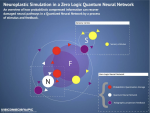 Neuroplasticity demonstrated in a Zero Logic Quantum Neural Network (ZLQNN)
Neuroplasticity demonstrated in a Zero Logic Quantum Neural Network (ZLQNN)
Toridion
September 15, 2015
The system demonstrates both simulated “neuroplasticity” and further that the fundamental act of making mistakes in self programming of a machine learning system is both a driver to finding solutions to known unknowns and developing neural pathways that can form “new opinions” that explore “unknown un
(3) (PDF) Neuroplasticity demonstrated in a Zero Logic Quantum Neural Network. Available from: https://www.researchgate.net/publication/281583936_Neuroplasticity_demonstrated_in_a_Zero_Logic_Quantum_Neural_Network [accessed Feb 20 2020].
See publication
Tags: AI, Predictive Analytics, Quantum Computing


 Scale-invariant Symmetry Breaking of a Musical Master-code from a 5-D Superfluid Sub-Quantum Space Is Instrumental in the Fabric of Reality, Life Conditions and Cosmic Consciousness
Scale-invariant Symmetry Breaking of a Musical Master-code from a 5-D Superfluid Sub-Quantum Space Is Instrumental in the Fabric of Reality, Life Conditions and Cosmic Consciousness
 Let AI Want Something?
Let AI Want Something?
 The Implications of Indestructible Memory in AI
The Implications of Indestructible Memory in AI
 TQNN vs. Transformers
TQNN vs. Transformers
 8% BTC hike more success for Quantum Inspired Machine Learning analytics engine Quantabotics
8% BTC hike more success for Quantum Inspired Machine Learning analytics engine Quantabotics

 The Artificial Intelligence Race won't be won by GPU's and TFLOPS
The Artificial Intelligence Race won't be won by GPU's and TFLOPS
 QUAKESCANNER MISSION I
QUAKESCANNER MISSION I
 An Artificial Life Developers Response to Deepak Chopra's Article - “Artificial Intelligence Will Never Rival the Deep Complexity of the Human Mind”
An Artificial Life Developers Response to Deepak Chopra's Article - “Artificial Intelligence Will Never Rival the Deep Complexity of the Human Mind”
 Question Generation Technology (QGT) in Deep Learning - Why Defining New Questions Is More Important Than Finding Answers in Data Analytics.
Question Generation Technology (QGT) in Deep Learning - Why Defining New Questions Is More Important Than Finding Answers in Data Analytics.
 Neuroplasticity demonstrated in a Zero Logic Quantum Neural Network
Neuroplasticity demonstrated in a Zero Logic Quantum Neural Network
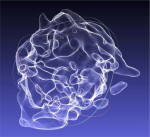 Re-constructing memory using quantized electronic music and a ‘Toridion byte’ quantum algorithm: Creating images using zero logic quantum probabilistic neural networks (ZLQNN)
Re-constructing memory using quantized electronic music and a ‘Toridion byte’ quantum algorithm: Creating images using zero logic quantum probabilistic neural networks (ZLQNN)
 Toridion QML API BTC (Bitcoin) Cryptocurrency Prediction Performance 37 Hr Test October 1st - 2nd 2020 Results with Data
Toridion QML API BTC (Bitcoin) Cryptocurrency Prediction Performance 37 Hr Test October 1st - 2nd 2020 Results with Data
 Quantum Inspired Machine Learning for Ethereum Cryptocurrency 2020 Forward Prediction with Results
Quantum Inspired Machine Learning for Ethereum Cryptocurrency 2020 Forward Prediction with Results
 Toridion Quantum Inspired Machine Learning for Ethereum Cryptocurrency Prediction with Results
Toridion Quantum Inspired Machine Learning for Ethereum Cryptocurrency Prediction with Results
 Computational Advantages of Probabilistic Quantum Neural Networks in 'Real World' Applications
Computational Advantages of Probabilistic Quantum Neural Networks in 'Real World' Applications
 The Third State: Toward a Quantum Information Theory of Consciousness
The Third State: Toward a Quantum Information Theory of Consciousness
 Neuroplasticity demonstrated in a Zero Logic Quantum Neural Network (ZLQNN)
Neuroplasticity demonstrated in a Zero Logic Quantum Neural Network (ZLQNN)

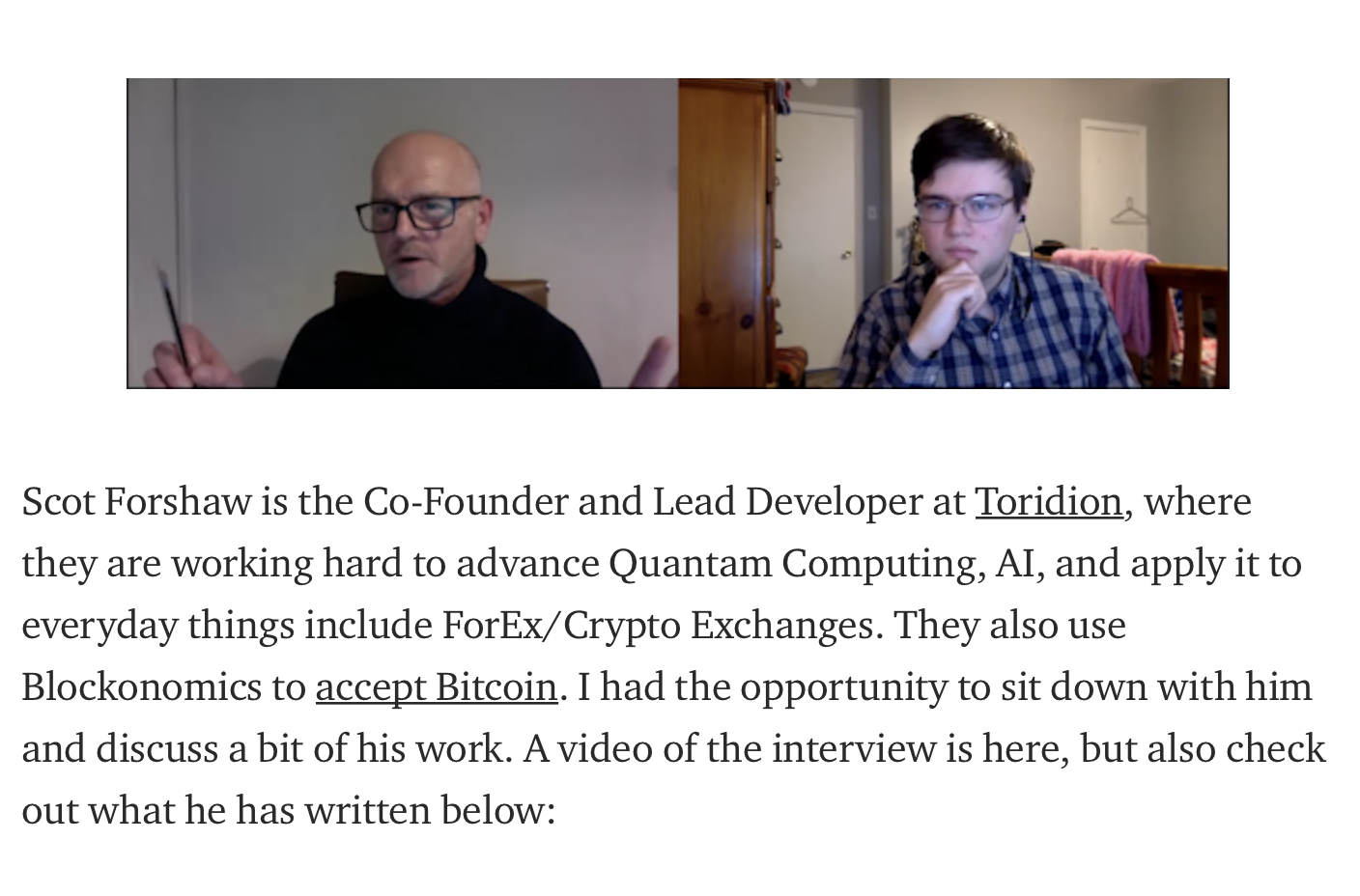 Quantum Computing, AI, and Bitcoin — Blockonomics Sits Down with Scot Forshaw, Co-Founder of Toridion
Quantum Computing, AI, and Bitcoin — Blockonomics Sits Down with Scot Forshaw, Co-Founder of Toridion


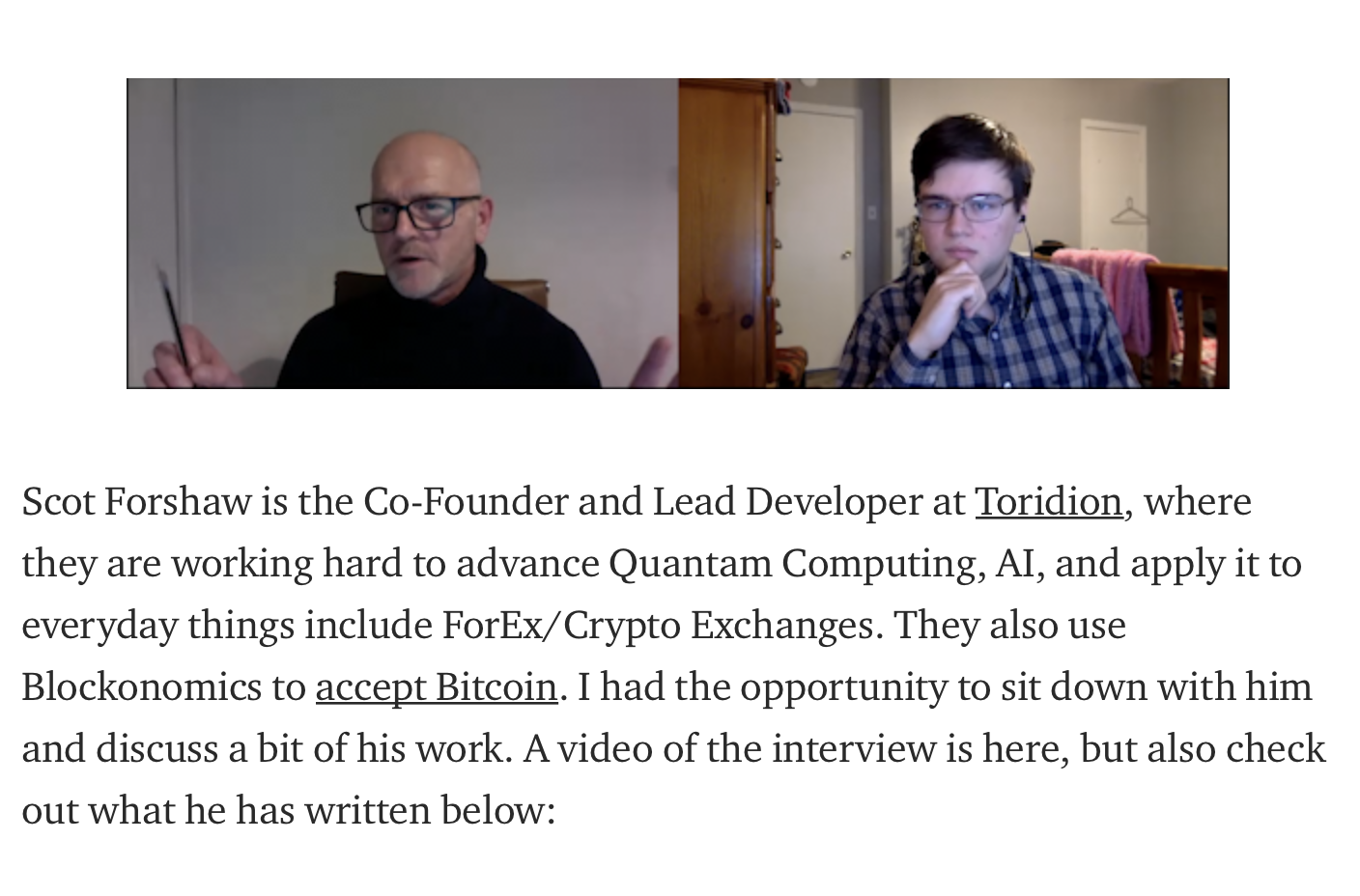 Quantum Computing, AI, and Bitcoin — Blockonomics Sits Down with Scot Forshaw, Co-Founder of Toridion
Quantum Computing, AI, and Bitcoin — Blockonomics Sits Down with Scot Forshaw, Co-Founder of Toridion


 Inside the mind of a Quantum Artificial Intelligence
Inside the mind of a Quantum Artificial Intelligence
 The Guardian Paradox Token Economics and the Limits of LLM Based Defences
The Guardian Paradox Token Economics and the Limits of LLM Based Defences Let AI Want Something?
Let AI Want Something? The Implications of Indestructible Memory in AI
The Implications of Indestructible Memory in AI